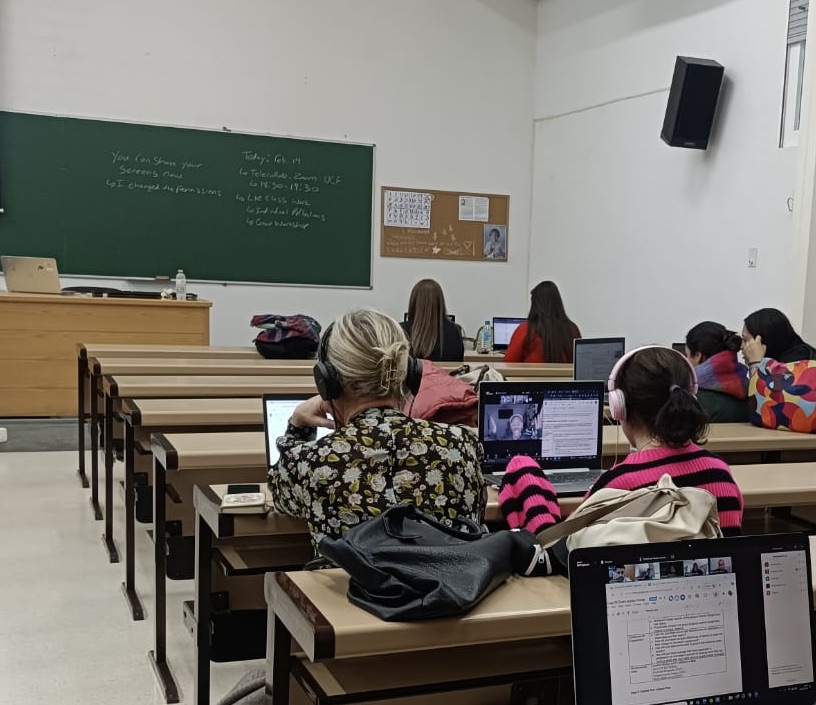Christina Torres, University of Central de Florida

Graduate students from the University of Huelva (UHU) and the University of Central Florida (UCF) are partnering this semester to create lesson plans with a multiliteracies emphasis for adult learners of English as part of their challenge-based coursework. This collaboration in the Teaching Innovations course at UHU is part of a Fulbright postdoctoral research grant project titled A Multiliteracies Approach to Telecollaborative Language Teacher Training and Service-Learning* which was awarded to Christina Torres, Ph.D., an assistant professor in TESOL at the University of Central Florida.
The students at UHU in the collaboration are studying in the Official Master’s Degree in Teacher Training for Secondary Education, Vocational Training, and Language Teaching (English Language Specialty), and the UCF students are in the Master’s in Teaching English to Speakers of Other Languages (MA TESOL) program or the graduate Teaching English as a Foreign Language (TEFL) certificate. Students from both universities completed shared training modules on Multiliteracies, instructional design for online environments, and telecollaboration. Then, they began planning their lessons using a combination of synchronous and asynchronous online communication with partners across the Atlantic.

For the lesson-planning assignment, students are working together in groups with international partners to create a lesson with a multiliteracies approach which will be delivered to adult English language learners in a synchronous online setting. The first synchronous planning session was on February 14, and English language students studying at Seminole State College in Florida will be joining us for the last synchronous session on February 27 where the UHU and UCF students will team-teach their created lessons.
Telecollaborative learning (also called virtual exchange) has been used in language teacher training to promote intercultural exchange through technology-mediated communication (O’Dowd & Vinagre, 2024). Foundational to telecollaboration is the establishment of tasks embedded in a course which offer participants authentic opportunities to negotiate intercultural differences and work towards a common goal (O’Dowd, 2015). While telecollaboration can be enacted using classes of teachers in training and classes of language learners, it is also being widely used to connect teachers to teachers (whether they are in-training or already practicing) as was done with the VALIANT project. The UHU-UCF collaboration project connects students in teacher training classes to work together and provides the groups an opportunity to work with English language students too.
The present project combines telecollaboration with multiliteracies pedagogy as a meaningful part of teacher training. First introduced by The New London Group (1996), multiliteracies is an approach to literacy education which expanded the traditional definition of literacy from reading and writing a standard national form of a language in print to one which focuses on empowering learners, celebrating their lifeworld diversity and encouraging multimodal communication. Later expanded within Learning by Design (e.g., Cope & Kalantzis, 2015; Kalantzis & Cope, 2023) multiliteracies pedagogy has continued to emphasize the goal of empowering students to actively engage in their learning process and in their communities. Multiliteracies pedagogy aligns with telecollaboration as they both emphasize the importance of developing intercultural communication (Fernández-García & Sánchez-Vizcaíno, 2023; Gutiérrez-Santiuste & Ritacco-Real, 2023; Guth & Helm, 2012), an important aspect of effective language teaching.

The project included collaboration with UHU faculty to create multimodal teacher training materials which were delivered in both the UHU Moodle and UCF Canvas class pages and coordination between the universities during a qualitative case study about the experiences of the teachers in training as they participate in this telecollaboration with a multiliteracies focus. Ultimately, the work on the case study offers an opportunity to investigate connections between multiliteracies and telecollaboration as part of English language teacher training. The study also provides the opportunity to develop a long-term relationship between the universities in order to continue telecollaboration projects in future years and this enriching intercultural experience with new groups of students as they train to be teachers.
*This Fulbright postdoctoral research grant project titled A Multiliteracies Approach for Telecollaborative Language Teacher Training and Service-Learning is hosted at the University of Huelva within the Research Center “Contemporary Thinking and Innovation for Social Development” Grupo de Investigación ReALL (Research in Affective Language Learning) and the PIONEER European University Alliance R+D+i Project “Multiliteracies for adult at-risk learners of additional languages (REF.PID2020- 113460RB-100). Gratitude is extended to the participating faculty group at the University of Huelva, especially Dr. M. Carmen Fonseca-Mora (fonseca@dfing.uhu.es), Dr. Beatriz Peña-Acuña, Dr. Analí Fernandez-Corbacho, and Dr. Carmen Toscano-Fuentes for their collaboration in this project.
Christina Torres (Christina.Torres@ucf.edu) is an assistant professor in TESOL at the University of Central Florida. Her research interests include written corrective feedback for L2 writers, language teacher training, multiliteracies, and instructional design. She is a principal investigator and coordinator for the virtual Center of Language Outreach, Research, and Study (COLORS) at UCF.
References
Cope, B. & Kalantzis, M. (Eds.). (2015). A pedagogy of multiliteracies: Learning by design. Palgrave Macmillan.
Fernández-García, A., & Sánchez-Vizcaíno, C. (2023). Developing intercultural competence in adult language learning through the multiliteracies approach: A systematic review. European Journal of Language Policy, 15(2), 191-215. https://doi.org/10.3828/ejlp.2023.11
Guth, S., & Helm, F. (2012). Developing multiliteracies in ELT through telecollaboration. ELT journal, 66(1), 42-51. doi:10.1093/elt/ccr027
Gutiérrez-Santiuste, E., & Ritacco-Real, M. (2023). Intercultural communicative competence in higher education through telecollaboration: Typology and development. Education and Information Technologies, 28(11), 13885-13912. https://doi.org/10.1007/s10639-023-11751-3
Kalantzis, M., & Cope, B. (2023) Multiliteracies: Life of an idea. The International Journal of Literacies, 30(2), 17-89. https://doi.org/10.18848/2327-0136/CGP/v30i02/17-89
O’Dowd, R. (2015). The competences of the telecollaborative teacher. The Language Learning Journal, 43(2): 194-207.https://doi.org/10.1080/09571736.2013.853374
O’Dowd, R. & Vinagre, M. (Eds.). (2024). Virtual innovation and support networks: Exploring the impact of virtual exchange in teacher education. Peter Lang
The New London Group: Cazden, C., Cope, B., Fairclough, N., Gee, J., Kalantzis, M., Kress, G., Luke, A., Luke, C., Michaels, S., & Nakata, M. (1996). A pedagogy of multiliteracies: Designing social futures. Harvard Educational Review, 66(1), 60-93. https://doi.org/10.17763/haer.66.1.17370n67v22j160u
